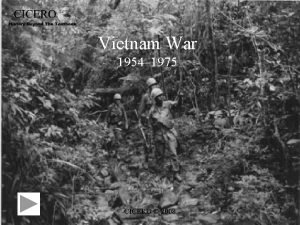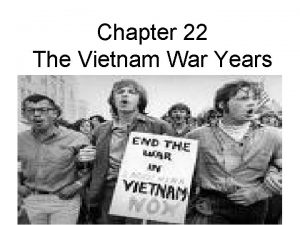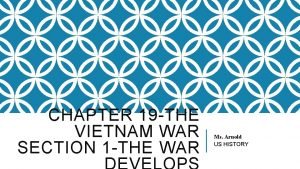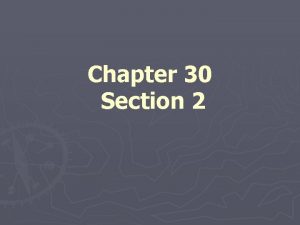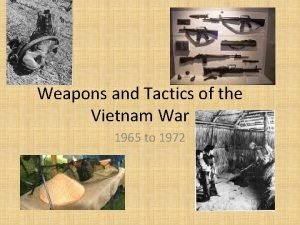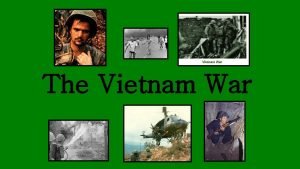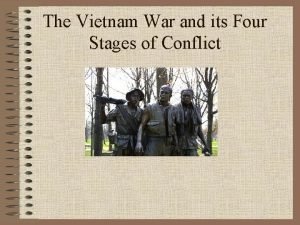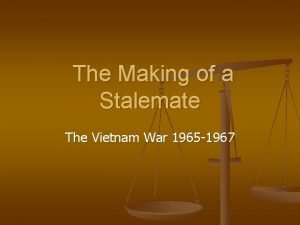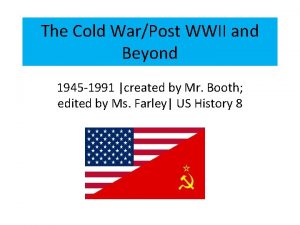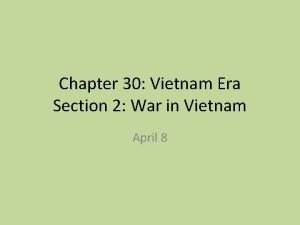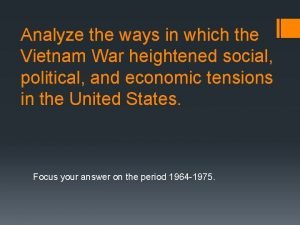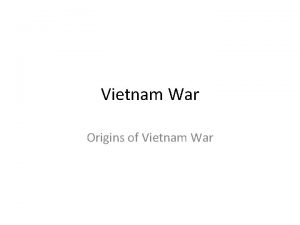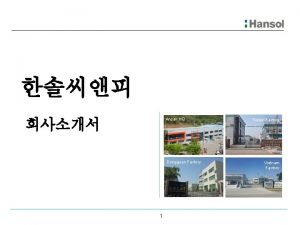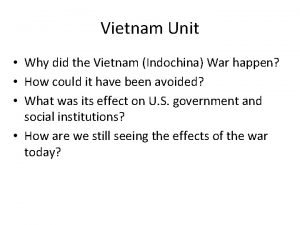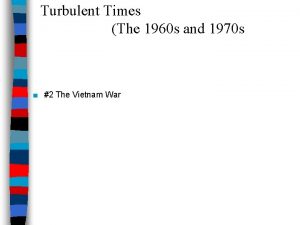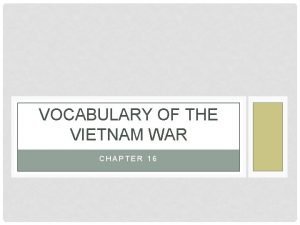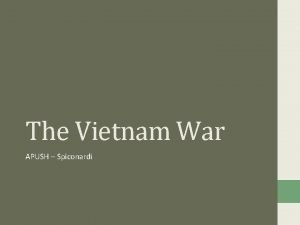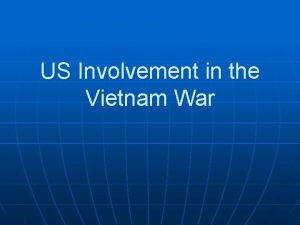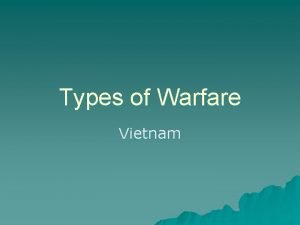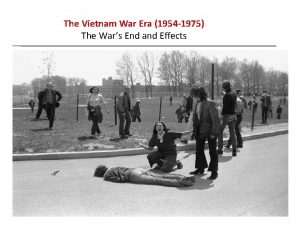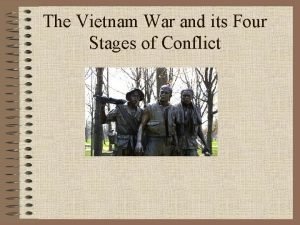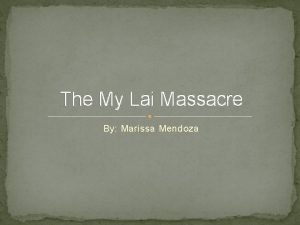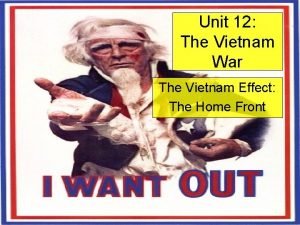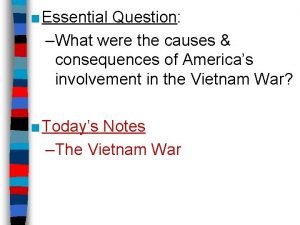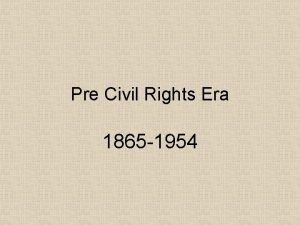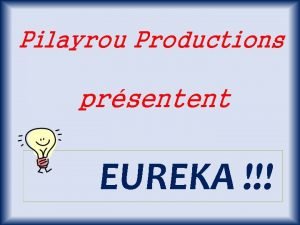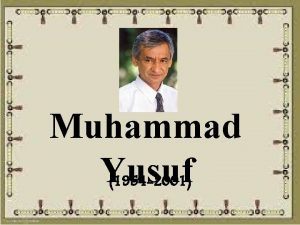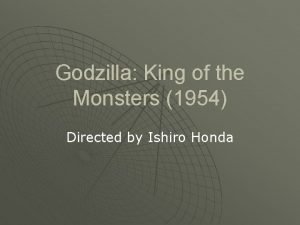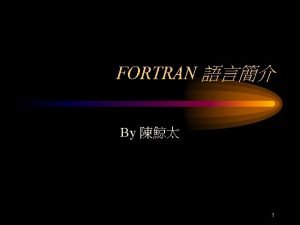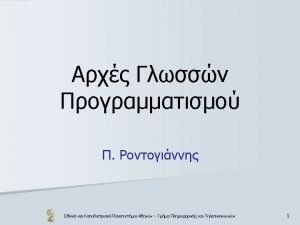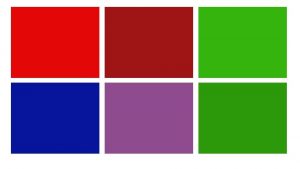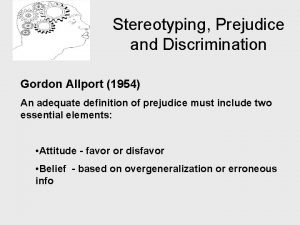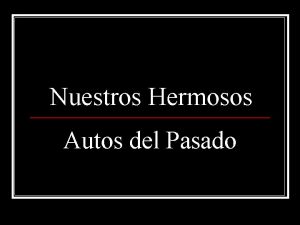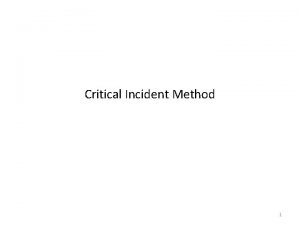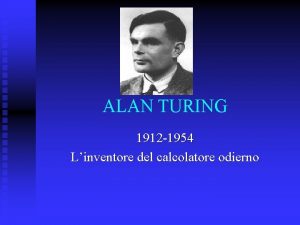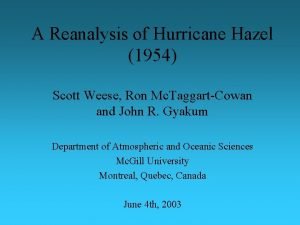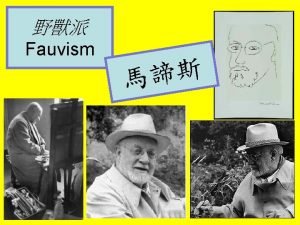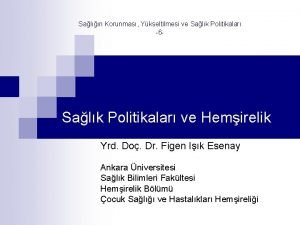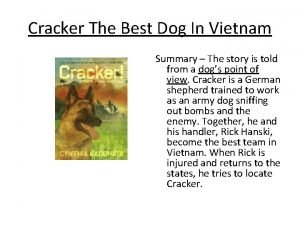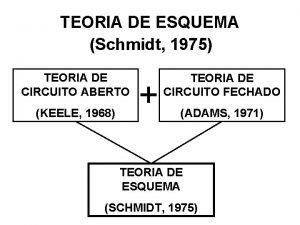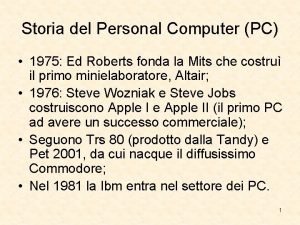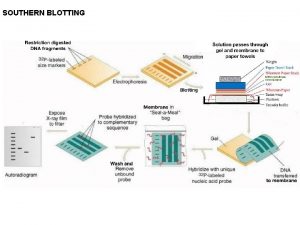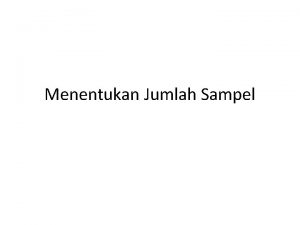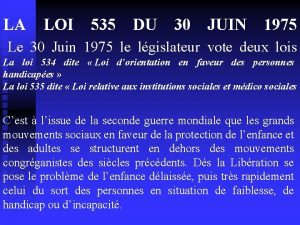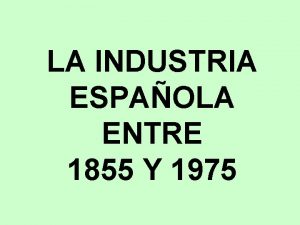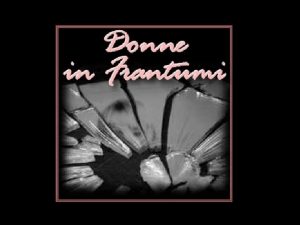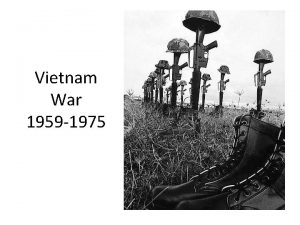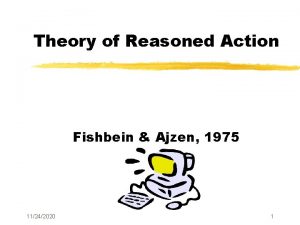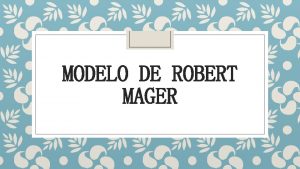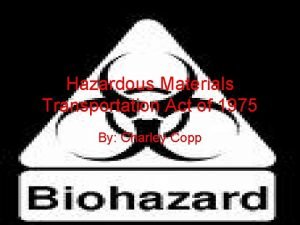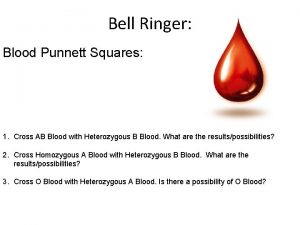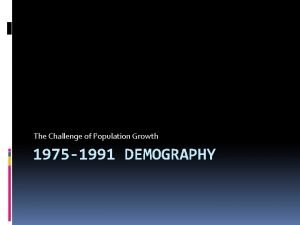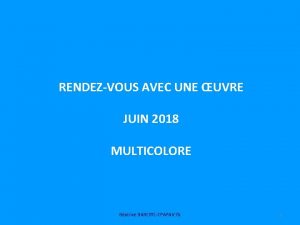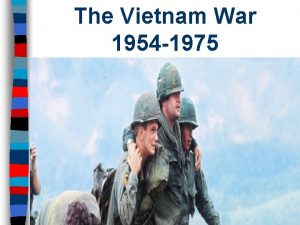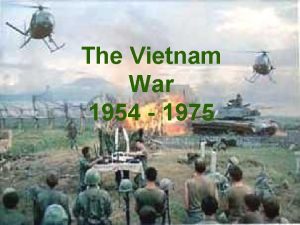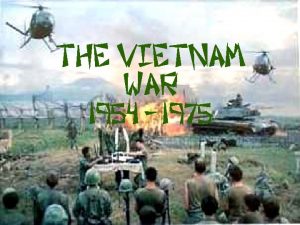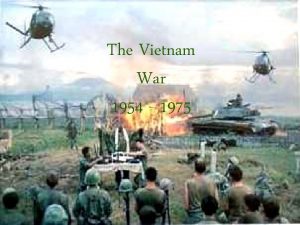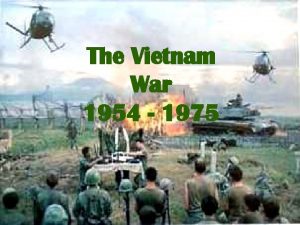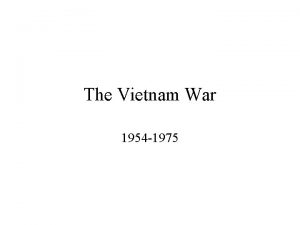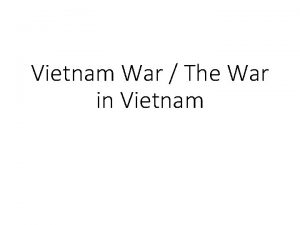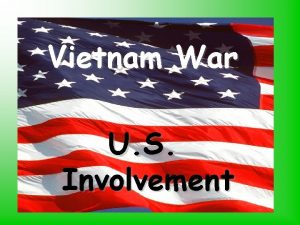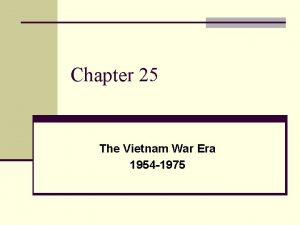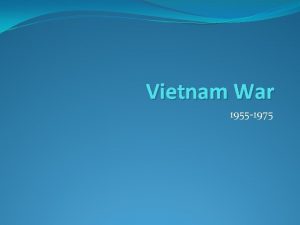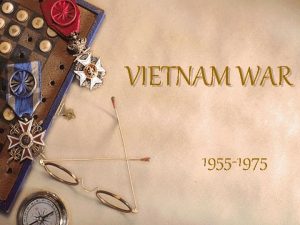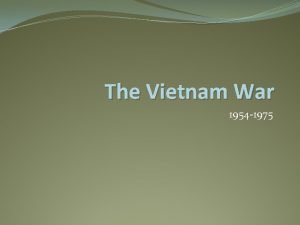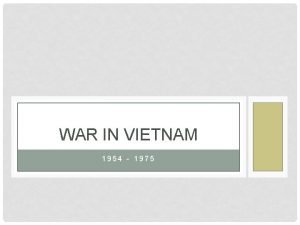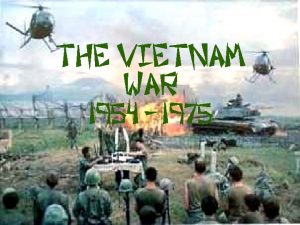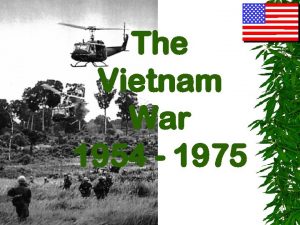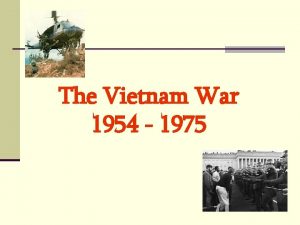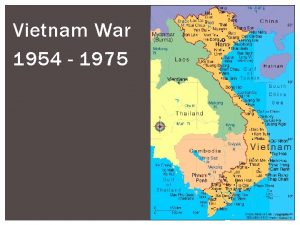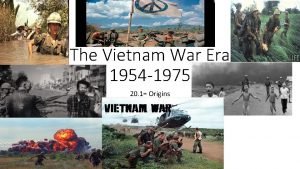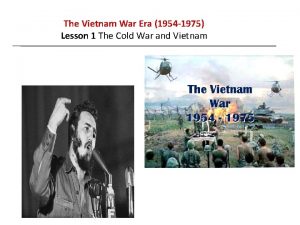CHAPTER 22 The Vietnam War 1954 1975 Early
































































- Slides: 64

CHAPTER 22 The Vietnam War 1954 -1975


Early Involvement in Vietnam Ø Ø Ø In the late 1940 s and 1950 s most Americans new little about Vietnam. During this time American officials came to view the nation as increasingly important in the campaign to halt the spread of communism. From the late 1800 s until WWII, France ruled Vietnam and neighboring Laos and Cambodia a region known collectively as French Indochina.

By the early 1900 s nationalism had become a powerful force in Vietnam. The Vietnamese formed several political parties to push for independence or reform of the French colonial government. One of the leaders of the nationalist movement was Nguyen Tat Thanh- better known as his alias Ho Chi Minh or “Bringer of Light. ”

Ho Chi Minh was born in central Vietnam in 1890. Was a strong advocate of communism. In 1930 he founded the Indochinese Communist Party and worked to overthrow French rule. His activities made him a wanted man. He fled Indochina and spent several years in exile in the Soviet Union and China.

In 1941 Ho Chi Minh returned to Vietnam. The Japanese had seized control of the country in 1941. Ho Chi Minh organized a nationalist group called the Vietminh- The group united both Communist and non. Communist in the struggle to expel the Japanese from Vietnam. The United States would get involved by sending aid to the Vietminh.

With the allies victory over Japan the Japanese surrendered control of Indochina. Ho Chi Minh and his forces announced that Vietnam was independent. Minh even drew up a declaration of independence. Archimedes Patti an American officer stationed in Vietnam helped Minh write the document.

Declaration of Independence of the Democratic Republic of Vietnam September 2, 1945 All men are created equal; they are endowed by their Creator with certain inalienable Rights; among these are Life, Liberty, and the pursuit of Happiness. This immortal statement was made in the Declaration of Independence of the United States of America in 1776. In a broader sense, this means: All the peoples on the earth are equal from birth, all the peoples have a right to live, to be happy and free. The Declaration of the French Revolution made in 1791 on the Rights of Man and the Citizen also states: "All men are born free and with equal rights, and must always remain free and have equal rights. " Those are undeniable truths. Nevertheless, for more than eighty years, the French imperialists, abusing the standard of Liberty, Equality, and Fraternity, have violated our Fatherland oppressed our fellow citizens. They have acted contrary to the ideals of humanity and justice.

France however had no intention of allowing Vietnam to gain their independence. Seeking to regain their colonial empire in Southeast Asia, French troops returned to Vietnam in 1946 and drove the Vietminh forces into hiding in the countryside. By 1949 French officials had set up a new government in Vietnam.

The Vietminh fought back against the French and slowly increased their control. The French appealed to the United States for help. The U. S. opposed colonialism. In Vietnam however the independence movement with the Communist movement. American officials did not think France should control Vietnam but they did not want Vietnam to be a Communist country.

Two events convinced the Truman administration to help France- fall of China to communism and the outbreak of the Korean War. Korea in particular convinced American officials that the Soviet Union had begun a major push to impose communism on East Asia. Shortly after the Korea war began, President Harry S. Truman authorized a massive program of military aid to French forces fighting in Vietnam.

President Eisenhower continued to support the French military campaign against the Vietminh. By 1954 the United States was paying roughly threefourths of France’s war cost. During a news conference in 1954 Eisenhower defended the U. S. policy in Vietnam by stressing what became known as the domino theorythe belief that if Vietnam fell to communism so too would the other nations in Southeast Asia

Despite the aid from the U. S. the French still struggled against the Vietminh who used hit-and- run and ambush tactics. These are the tactics of guerrillas irregular troops who usually blend into the civilian population and are often difficult for regular armies to fight. The mounting causalities and inability of the French to defeat the Vietminh made the war very unpopular with the French.

In 1954 the French commander ordered his forces to occupy the mountain town of Dien Bien Phu. Seizing the town would interfere with Vietminh’s supply line and force them into open battle. Soon afterward a huge Vietminh force surrounded Dien Bien Phu and began bombarding the town.

Shells rained down on us without stopping like a hailstorm on a fall evening, ” recalled on French soldier. Bunker after bunker trench after trench collapsed burying under them men and weapons. ” On May 7, 1954 the French force at Dien Bien Phu fell to the Vietminh. The defeat convinced the French to make peace and withdraw from Indochina.

Negotiations to end the conflict were held in Geneva, Switzerland. The Geneva Accords temporarily divided Vietnam along the 17 th parallel with Ho Chi Minh and the Vietminh in control of North Vietnam and pro-Western regime in control of the South. In 1956 elections were to reunite the country under a single government. After the Geneva Accords the French finally left Vietnam.

The U. S. almost immediately stepped in to protect the new government in the South led by Ngo Dinh Diem a pro-Western and anti-Communist. The tension between the North and South Vietnam escalated with the United States in the middle. President Dwight D. Eisenhower supported Diem and increased American military and economic aid to South Vietnam.

After Ngo Dinh Diem refused to hold national elections, Ho Chi Minh and his followers created a new guerrilla army known as the Vietcong. The VC’s goal was to reunify North and South Vietnam. The U. S. continued to send aid to South Vietnam. The Vietcong's power however continued to grow because many Vietnamese opposed Diem’s government.

President Kennedy continued the nation’s policy of support for South Vietnam, agreeing with past presidents that Southeast Asia was important in the battle against communism. The unpopularity of South Vietnam’s President Diem increased because his government was corrupt he created strategic hamlets and he discriminated against Buddhism one of the country’s most widely practiced religions. Diem was overthrown and later executed. This further weakened South Vietnam’s government, forcing the U. S. to become more involved.


After President Kennedy’s assassination, President Johnson inherited the problem of Vietnam. At first President Johnson was cautious regarding Vietnam, yet he was determined to prevent South Vietnam from becoming Communist. Politically, Democrats needed to keep South Vietnam from becoming Communist or Republicans would use it against them.

On August 2, 1964 President Johnson announced that North Vietnamese torpedo boats fired on two American destroyers in the Gulf of Tonkin. A similar attack reportedly occurred two days later. The Senate and the House passed the Gulf of Tonkin Resolution on August 7, 1964, authorizing the president to take all necessary measures to repel any armed attack on U. S. forces. Congress had given its war powers to the president.



After the Gulf of Tonkin Resolution was passed the Vietcong began attacking bases where American advisers were stationed in South Vietnam. After an attack in February 1965, Johnson sent aircrafts to strike in North Vietnam. While the polls showed that Johnson’s approval rating had increased some dissenters in the White House warned that if the United States became too involved, it would be difficult to get out.

In March 1965 however Johnson increase American involvement, and American soldiers were fighting alongside the South Vietnamese troops against the Vietcong. 1965: US orders 50, 000 troops to Vietnam. By the end of 1965 there were some 180, 000 American combat troops fighting in Vietnam with the number doubling by 1966. Many Americans believed they could win in Vietnam.

A Bloody Stalemate Emerges To take Vietcong’s hiding places away American planes dropped napalm a jellied gasoline that explodes on contact and Agent Orange a chemical that strips leaves from trees and shrubs. Farmlands and forest were turned into wastelands. Americans underestimated the Vietcong’s strength, stamina, and morale.


Planes spraying Agent Orange defoliant on Vietnam in 1966. Over 100, 000 tons of herbicides (Agents Blue, Orange, Pink, Purple and White) were dropped on Vietnam in attempt to deprive Viet Cong of food and forest cover. New study shows 2 to 4 million people were sprayed directly with the chemicals which contained concentrations of dioxin more than 100 times greater than normal. In additional to killing many thousands, U. S. chemical warfare left legacy of half a million Vietnamese children suffering from birth defects, according to the Wall Street Journal.


Johnson refused to order a full invasion of North Vietnam fearing China would get involved in the war. President Johnson refused to order a full-scale attack on the Vietcong’s supply line known as the Ho Chi Minh Trail. This made winning difficult. As American casualties increased many Americans citizens began questioning the United States's involvement in the war.

In March 1965 President Johnson expanded American involvement by shifting his policy to a sustained bombing campaign against North Vietnam. The campaign was named Operation Rolling Thunder. March 1965 the president also ordered the first combat troops to Vietnam. Many Americans troops were frustrated by the Vietcong because they used ambushes , booby traps, and hit and run tactics. The VC also blended into the general population in cities and country side and would just vanish.


Growing Credibility Gap When American troops first entered the Vietnam War many Americans supported the war effort. As the war in Vietnam continued to drag on the public support decreased. Americans began to question the government and believed a credibility gap and developed making it difficult to believe what the Johnson administration said about the war.

Throughout the early years of the war the American Commander in Vietnam General William Westmoreland reported that the enemy was on the brink of defeat. In 1967 he confidently declared that the “enemy’s hopes are bankrupt” and added “we have reached an important point where the end begins to come into view. ”

The Vietnam War was the first television war combat footage appeared nightly on the evening news.

Antiwar Movement As casualties increased, Americans especially college students began to publicly protest the war. In March 1965 faculty and students at the University of Michigan abandoned their classes and formed a teach-in where they informally discussed issues of the war and why they opposed it. This triggered teach-ins at many college campuses.


Kent State Incident What had merely been a small campus demonstration— one of thousands nationwide, quickly developed into a symbol of the Vietnam era in America. President Richard Nixon's announcement of the U. S. invasion of Cambodia and the need to draft more soldiers for an expansion of the Vietnam War effort provoked massive protests on campuses throughout the country. At Kent State University in Ohio, demonstrators occupied buildings and destroyed the ROTC offices. In response, the governor of Ohio dispatched hundreds of National Guardsmen to the campus. On May 4, the guardsmen open fire on a crowd of protesters, killing four student and wounding nine others.


Young protestors focused their attention on what they felt was an unfair draft system. While college students could delay military service until graduation, those with low income and limited education were called to serve. As a result minorities especially African Americans were called to war. Many draftees refused to serve. Others moved to Canada and other nations. No new draft orders were issued after 1972.

THE VIETNAM LOTTERIES A lottery drawing - the first since 1942 - was held on December 1, 1969, at Selective Service National Headquarters in Washington, D. C. This event determined the order of call for induction during calendar year 1970; that is, for registrants born between January 1, 1944, and December 31, 1950. Reinstitution of the lottery was a change from the "draft the oldest man first" method, which had been the determining method for deciding order of call.

There were 366 blue plastic capsules containing birth dates placed in a large glass container and drawn by hand to assign order-of -call numbers to all men within the 18 -26 age range specified in Selective Service law.

By 1968 the nation seemed divided into two camps the doves and the hawks. The doves wanted the U. S. to withdraw from the war and the hawks felt the U. S. should stay and fight.

Voting Protest over the draft led to discussion about the right of draft age citizens to vote and the passage of the 26 th Amendment. The 26 th Amendment to the Constitution was ratified giving all citizens age 18 and older the right to vote in all state and federal elections.

1968 The Pivotal Year On January 30, 1968 during Tet the Vietnamese New Year, the Vietcong and North Vietnamese launched a surprised attack known as Tet Offensive. In the attack guerrilla fighters hit American airbases in South Vietnam as well as the South’s major cities and provincial capitals. Militarily the Tet offensive was a disasters for the Communists but it was a political victory that shocked Americans. As a result the approval rating plummeted.

The Tet Offensive was a series of surprise attacks by the Vietcong (rebel forces sponsored by North Vietnam) and North Vietnamese forces, on scores of cities, towns, and hamlets throughout South Vietnam. It was considered to be a turning point in the Vietnam War. North Vietnamese leaders believed they could not sustain the heavy losses inflicted by the Americans indefinitely and had to win the war with an all-out military effort. In addition, Ho Chi Minh was nearing death, and they needed a victory before that time came. The combined forces of the Vietcong and the North Vietnamese Regular Army (NVA), about 85, 000 strong, launched a major offensive throughout South Vietnam.

The attacks began on January 31, 1968, the first day of the Lunar New Year, Vietnam's most important holiday. It took weeks for U. S. and South Vietnamese troops to retake all of the captured cities, including the former imperial capital of Hue. Even though the offensive was a military failure for the North Vietnamese Communists and Vietcong (VC), it was a political and psychological victory for them because it dramatically contradicted optimistic claims by the U. S. government that the war was all but over.


Senator Eugene Mc. Carthy and Senator Robert Kennedy would enter the 1968 presidential race as “dove” candidates for the Democratic nomination. Johnson withdrew from the presidential race announcing his decision in an address to the nation on March 31, 1968.

In April of 1968 Dr. Martin Luther King would be assassinated. Two months later Senator Robert Kennedy would also be assassinated. This violence coupled with a clash between protestors and police at the Democratic National Convention in Chicago in August , left the nation in a state of chaos.

The chaos benefited the Republican presidential candidate, Richard Nixon and an independent candidate, Governor George C. Wallace of Alabama. Nixon promised to regain order and end the war in Vietnam. Although Johnson attempted to help the Democratic campaign with a cease-fire Democratic presidential nominee Hubert Humphrey lost by more than 100 electoral votes as well as the popular vote by a slim margin. Richard Nixon became the 37 th president of the United States.


Nixon Moves to End the War President Nixon chose Harvard Professor Henry Kissinger to be special assistant for national security affairs giving him authority to find a way to end the war in Vietnam. Kissinger used a policy he called linkage to improve relations with the Soviet Union and China-the suppliers of aid to North Vietnam.

Nixon started the gradual withdrawal of American troops in Vietnam allowing South Vietnam to assume more of the fighting this became known as Vietnamization. As peace negotiations were underway, Nixon increased air strikes against North Vietnam to maintain American strength.

Turmoil at Home Continues The Vietnam War continued to stir up protests and violence in the United States. In 1969 Americans learned of a 1968 event that further increased their feelings that this was a senseless war. An American platoon under the command of Lieutenant William Calley had massacred more than 200 unarmed South Vietnamese civilians in the hamlet of My Lai. Most of the victims were old men, women, and children.


In April 1970 President Nixon announced that American troops had invaded Cambodia to destroy Vietcong military base. Americans viewed this as an expansion of the war and a wave of protests followed. In 1970 Congress repealed the Gulf of Tonkin Resolution that had given the president near complete power in directing the war.

In 1971 a former Defense Department worker, Daniel Ellsberg leaked what became known as the Pentagon Papers to the press. The secret document showed that many government officials had privately questioned the war while publicly defending it. The document also showed how the various government had not been honest about Vietnam.

U. S. Pulls Out of Vietnam By 1971 nearly two-thirds of Americans wanted the Vietnam War to end. President Nixon dropped the insistence that North Vietnam had to withdraw from South Vietnam before a peace treaty could be signed. A month before the presidential election Henry Kissinger announced that peace was at hand. Nixon won re-election in a landslide.

Peace negotiations broke down when South Vietnam’s president refused any plan that left North Vietnamese troops in South Vietnam. The U. S. began a bombing campaign that eventually led to the resumption of peace talks. On January 27, 1973 the sides agreed to end the war and restore peace in Vietnam. After eight years at war the longest in American history the U. S. ended its direct involvement in Vietnam.

In March 1975 the North Vietnamese army launched a full-scale invasion of the South Vietnam asked for U. S. aid but Congress refused to help. April 30, the North Vietnamese captured Saigon, united Vietnam under Communist rule and renamed Saigon, Ho Chi Minh City.

The Legacy of Vietnam The Vietnam War had a lasting impact on the U. S. The war had cost over $170 billion in direct costs and had resulted in 58, 000 deaths. Many soldiers who did return home faced psychological problems, some families were left uncertain about POWs and MIAs.

In 1973 Congress passed the War Powers Act to reestablish limits on executive power. The act required the president to inform Congress of any commitment of troops abroad within 48 hours and to withdraw them in 60 to 90 days unless Congress approved the troop commitment. The Vietnam War increased Americans’ cynicism about their government and made them question their leaders. The Vietnam War affect Americans toward international conflicts in that most Americans became more reluctant to intervene in other countries affairs.
 1975-1954
1975-1954 Vietnam war
Vietnam war Presidential and radical reconstruction venn diagram
Presidential and radical reconstruction venn diagram The vietnam war years chapter 22
The vietnam war years chapter 22 Chapter 19 the vietnam war
Chapter 19 the vietnam war Chapter 30
Chapter 30 Us weapons vietnam war
Us weapons vietnam war Vietnam war results
Vietnam war results Stages of the vietnam war
Stages of the vietnam war Did the vietnam war end in a stalemate
Did the vietnam war end in a stalemate Vietnam war at home webquest answers
Vietnam war at home webquest answers Vietnam war causes
Vietnam war causes Analyze the ways in which the vietnam war heightened social
Analyze the ways in which the vietnam war heightened social The vietnam war
The vietnam war Vietnam war
Vietnam war Operation rolling thunder cold war
Operation rolling thunder cold war Vietnam war 1960
Vietnam war 1960 Vietnam war vocabulary
Vietnam war vocabulary Vietnam war apush
Vietnam war apush Vietnam
Vietnam Vietnam war traps
Vietnam war traps Reason for vietnam war
Reason for vietnam war Effects of the vietnam war
Effects of the vietnam war Stages of the vietnam war
Stages of the vietnam war Marissa lai
Marissa lai Vietnam
Vietnam What were the causes and effects of the vietnam war
What were the causes and effects of the vietnam war 15 th ammendment
15 th ammendment Magnétoscope 1954
Magnétoscope 1954 Muhammad yusuf maylida kimgadir yoqsa yoqmasa
Muhammad yusuf maylida kimgadir yoqsa yoqmasa Godzilla king of the monsters 1954
Godzilla king of the monsters 1954 Fortran 1954
Fortran 1954 Fortran
Fortran Color 15111999
Color 15111999 Where was ruby bridges born
Where was ruby bridges born Allport 1954
Allport 1954 Frida kahlo 1907 a 1954
Frida kahlo 1907 a 1954 Ron hubbard 1954
Ron hubbard 1954 1954 chevrolet bel air
1954 chevrolet bel air Incident method
Incident method 1954
1954 Hurricane morgan 1954
Hurricane morgan 1954 Point o woods old lyme ct
Point o woods old lyme ct 1954-1869
1954-1869 Başhemşire nasıl olunur
Başhemşire nasıl olunur Chapter 30 the war to end war
Chapter 30 the war to end war Chapter 30 the war to end war
Chapter 30 the war to end war Early cpr and early defibrillation can: *
Early cpr and early defibrillation can: * Cracker the best dog in vietnam
Cracker the best dog in vietnam Teoria de esquema de schmidt
Teoria de esquema de schmidt 1975 pc
1975 pc Who invented blotting technique in 1975? *
Who invented blotting technique in 1975? * Formula jacob cohen
Formula jacob cohen 30 juin 1975
30 juin 1975 La industria española entre 1855 y 1975
La industria española entre 1855 y 1975 29 settembre 1975
29 settembre 1975 Chalice
Chalice 1975-1959
1975-1959 Fishbein ajzen 1975
Fishbein ajzen 1975 Robert frank mager
Robert frank mager Hazardous materials transportation act of 1975
Hazardous materials transportation act of 1975 Blue people eastern kentucky
Blue people eastern kentucky 1991-1975
1991-1975 Dan lortie schoolteacher
Dan lortie schoolteacher Palette de tony cragg
Palette de tony cragg
